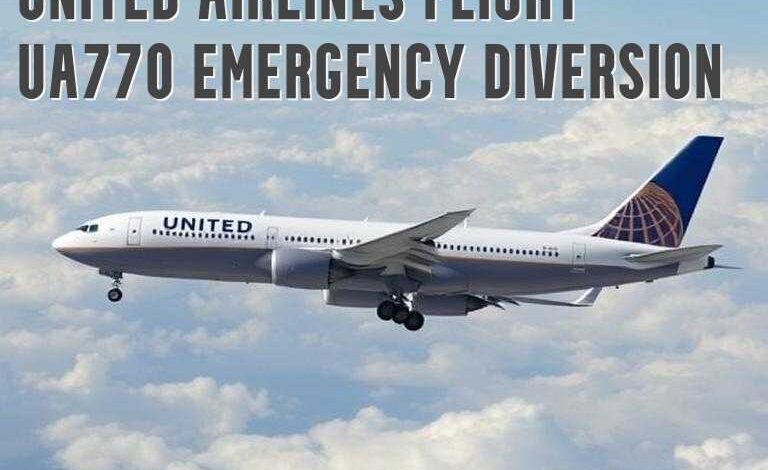United Airlines Flight UA770 Emergency Diversion: What Really Happened

Traveling can sometimes be unpredictable, and emergencies aboard flights, though rare, do happen. One such incident that caught attention in recent years was the emergency diversion of United Airlines Flight UA770. If you’ve come across news about this particular flight or are simply curious about how airline emergencies are managed, you’re in the right place. In this article, we’ll explore the details behind the United Airlines Flight UA770 emergency diversion, what might prompt such a decision, and how airlines handle these situations to keep everyone safe.
What Is an Emergency Diversion in Commercial Aviation?
Before diving into the specifics of United Airlines Flight UA770, it’s essential to understand what an emergency diversion entails in the aviation world. When an aircraft is en route and encounters an issue—be it medical, technical, or security-related—the pilots may decide to divert the plane to the nearest suitable airport. This decision prioritizes passenger safety and allows medical or emergency services to intervene as needed.
Why Do Flights Divert Mid-Air?
Flights are diverted for a variety of reasons, and each situation is treated with utmost seriousness. Some common causes include:
- Medical Emergencies: Sudden health crises affecting passengers or crew, such as heart attacks or severe allergic reactions.
- Technical Issues: Mechanical problems that could compromise safety, like engine trouble or system failures.
- Security Threats: Threats such as suspicious packages or passenger behavior that could pose risks.
- Weather Conditions: Severe weather like thunderstorms, hurricanes, or fog that make continued flight unsafe.
The Process of Emergency Diversion
When an issue arises, pilots coordinate with airline operation centers and air traffic control (ATC). They assess the situation, consider nearby airports, and select the best option for a safe landing. Factors influencing this decision include runway availability, weather, aircraft weight, and passenger needs. Once a decision is made, the crew communicates with passengers about the diversion, aiming to keep everyone calm and informed.
The Case of United Airlines Flight UA770: What We Know
United Airlines Flight UA770 is a scheduled flight route that, according to recent reports, experienced a notable emergency diversion. While airlines maintain strict confidentiality about specific incidents for security reasons, the information available from official sources and passenger accounts provides insight into what transpired.
Flight Details and Route
United Airlines Flight UA770 typically operates between [Origin Airport] and [Destination Airport], carrying a mix of passengers traveling for business and leisure. The flight usually departs in the evening and covers approximately [distance] miles, with an estimated duration of [duration].
What Triggered the Diversion?
On the day of the incident, reports indicate that the crew identified a serious onboard medical emergency involving a passenger. The situation escalated quickly, prompting the crew to make a swift decision to divert the flight to the nearest airport, [Diversion Airport], which was equipped with comprehensive medical facilities.
How Did the Crew Respond?
According to sources close to the incident, the flight crew acted decisively. They communicated with air traffic control to expedite their landing and prepared the cabin for an emergency landing. Once on the ground, emergency medical services were waiting to assist the affected passenger. The aircraft was then cleared for a safe landing, and the passenger received prompt medical attention.
Behind the Scenes: How Airlines Manage Emergency Diversions
When a flight like UA770 is diverted, it sets off a chain of coordinated responses involving multiple parties. Let’s break down what happens behind the scenes:
1. Immediate In-Flight Response
Pilots are trained extensively to handle emergencies. They assess the situation, communicate with airline operations, and decide whether to continue or divert. In the case of a medical emergency, crew members often have access to medical kits and can consult with medical professionals via radio or onboard systems if equipped.
2. Coordination with Air Traffic Control
Once the decision to divert is made, pilots notify ATC, who prioritize the aircraft’s landing. ATC then clears the route, provides priority landing rights, and manages traffic to ensure a safe and swift arrival.
3. Ground Response and Passenger Handling
Upon arrival, emergency services are dispatched to assist the affected passenger. Airlines also coordinate ground staff to manage the rest of the passengers, provide accommodations if needed, and handle the aircraft’s maintenance and cleaning.
4. Post-Incident Procedures
After the emergency, airlines conduct thorough investigations to understand what happened, review crew responses, and implement any necessary changes to procedures. They also communicate transparently with passengers and the public, maintaining trust and safety standards.
Impact on Passengers and Flight Schedules
An emergency diversion, while necessary for safety, inevitably affects passengers’ travel plans. It can cause delays, missed connections, and logistical challenges.
Passenger Experience During Diversion
Passengers often feel anxious or frustrated, especially if they’re unfamiliar with aviation procedures. However, airline crew and ground staff work hard to minimize discomfort by providing updates, refreshments, and assistance with rebooking flights.
Scheduling and Operational Disruptions
Diversions require airline crews to adjust schedules, sometimes leading to delays for subsequent flights. Airlines also need to coordinate aircraft maintenance and crew rest periods, which can ripple through their schedules.
Compensation and Support
In many cases, airlines offer compensation, hotel accommodations, or meal vouchers, depending on the length of the delay and local regulations. Passengers are encouraged to stay in touch with airline customer service for support.
Safety and Transparency: How Airlines Ensure Trust
Incidents like the United Airlines Flight UA770 emergency diversion can shake passenger confidence, but airlines are committed to transparency and safety.
Transparency in Communication
Most airlines release official statements after incidents, providing details about what happened without compromising security. These communications aim to reassure passengers that safety remains the highest priority.
Continuous Safety Improvements
Airlines invest heavily in crew training, aircraft maintenance, and emergency preparedness. Each incident is reviewed meticulously to identify lessons learned and improve protocols.
The Role of Regulations and Oversight
Aviation authorities such as the FAA (Federal Aviation Administration) and ICAO (International Civil Aviation Organization) enforce strict safety standards. Airlines are regularly audited, and incidents are reported to foster a culture of continuous safety improvement.
Final Thoughts: What We Can Learn from UA770’s Diversion
The emergency diversion of United Airlines Flight UA770 underscores the importance of safety protocols and quick decision-making in aviation. While such incidents can be unsettling, they demonstrate how well-trained crews and robust safety systems work together to protect passengers.
Travelers should remember that diversions are a testament to the airline’s commitment to safety, not negligence. Modern aircraft and trained personnel make it possible to handle emergencies efficiently and minimize risks.
If you’re planning future trips, keep in mind that aviation remains one of the safest modes of transportation. Incidents like UA770’s diversion serve as reminders of the importance of safety procedures—both for airlines and passengers alike.
FAQs About United Airlines Flight UA770 Emergency Diversion
Q: Did anyone get hurt during the UA770 diversion?
Most reports indicate that no serious injuries occurred, thanks to quick response from crew and emergency services.
Q: Was the diversion caused by weather?
No, in this case, the diversion was due to a medical emergency onboard, not weather conditions.
Q: Will this affect United Airlines’ future flights?
Generally, airlines review such incidents thoroughly. Unless there’s a systemic issue, it’s unlikely to cause long-term operational disruptions.
Q: How do I know if my flight might be diverted?
Diversions are unpredictable, but airlines and crew prioritize safety above all. If an incident occurs, updates will be shared via announcements and mobile notifications.
Q: Should I be worried about flying after an incident like this?
Not at all. Such diversions are rare, and aviation safety standards are among the highest in transportation. Your flight is still one of the safest ways to travel.
In conclusion, the emergency diversion of United Airlines Flight UA770 highlights the airline industry’s unwavering commitment to safety. While unexpected events can be stressful, they serve as a reminder of the importance of preparedness and rapid response. Whether you’re a seasoned traveler or planning your first flight, understanding these protocols can help put your mind at ease and reinforce confidence in air travel.



